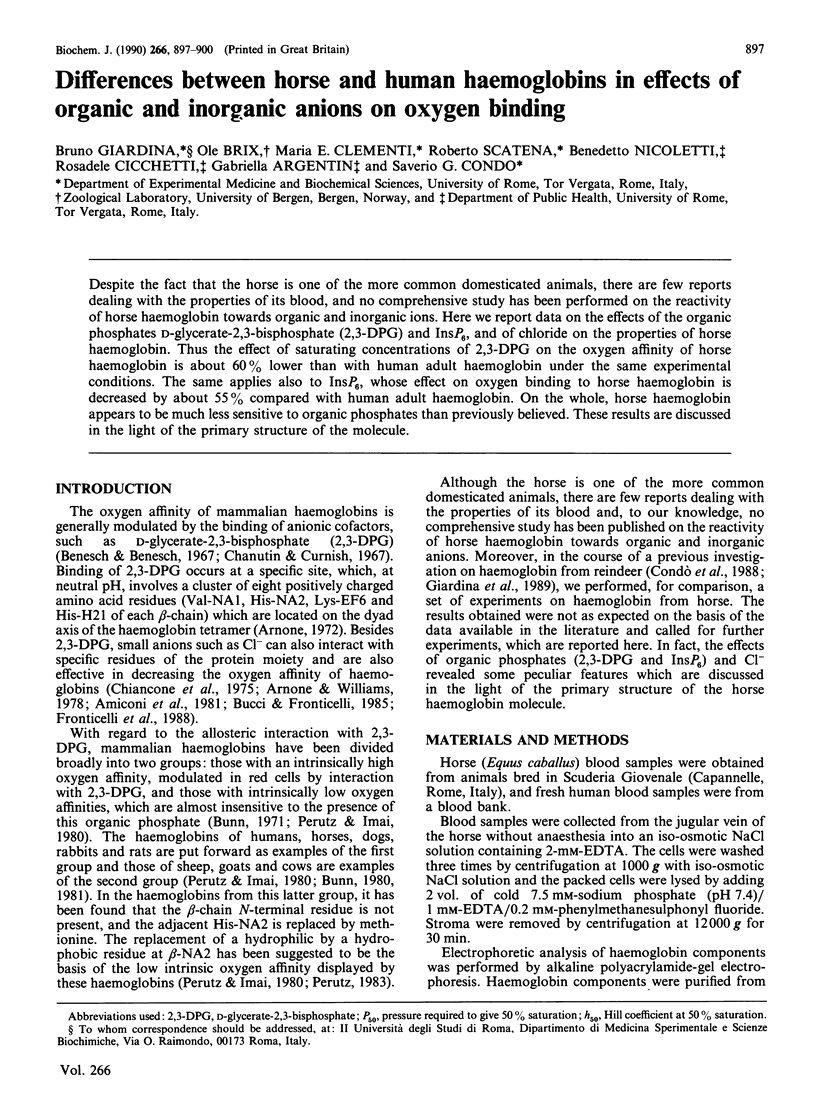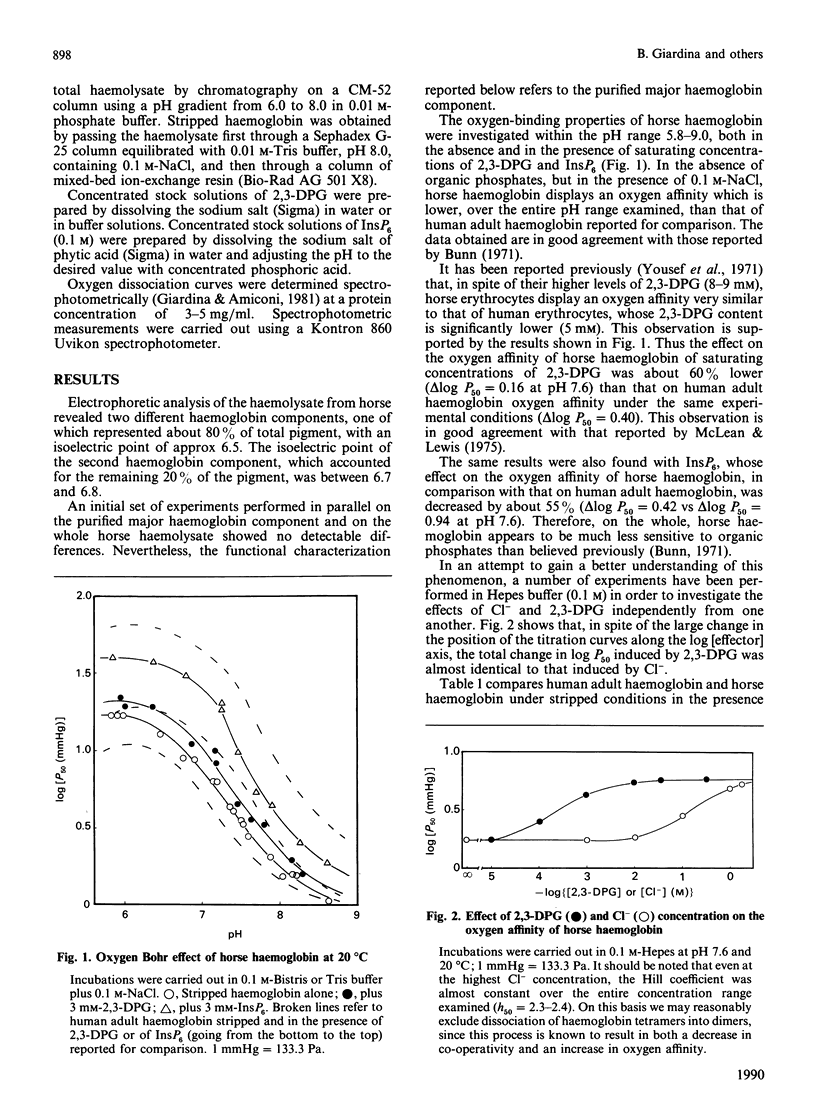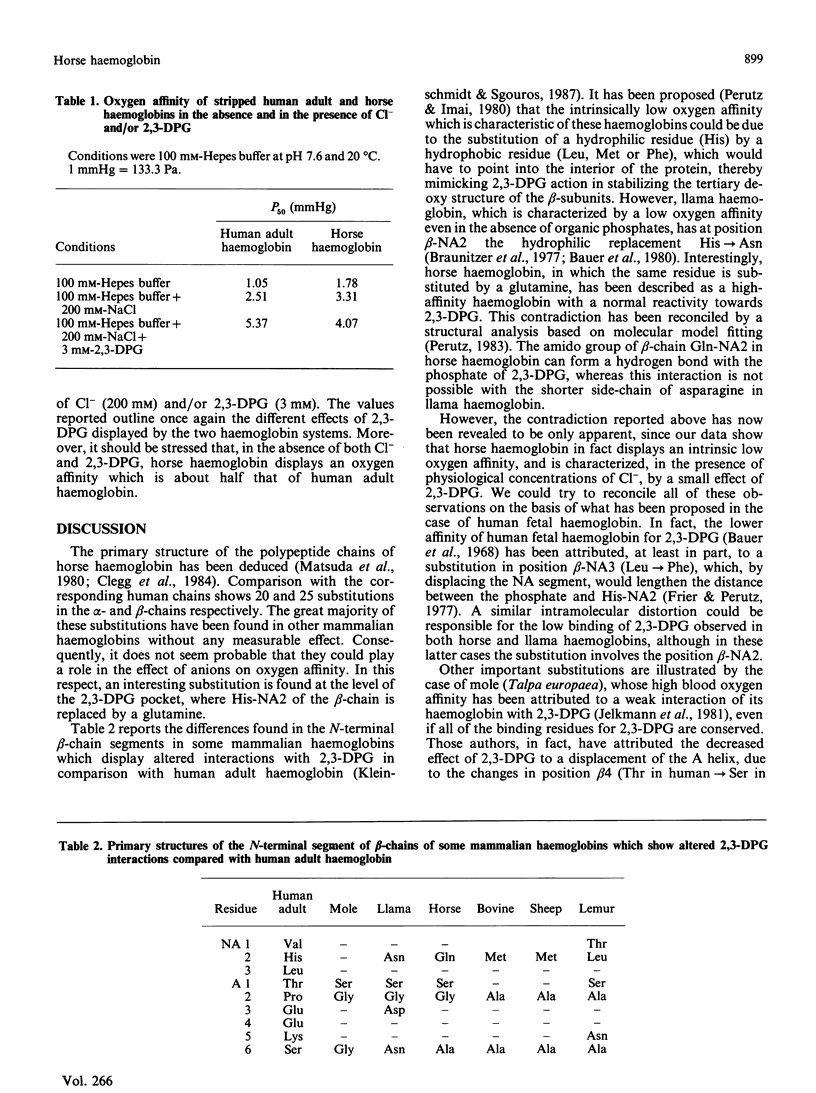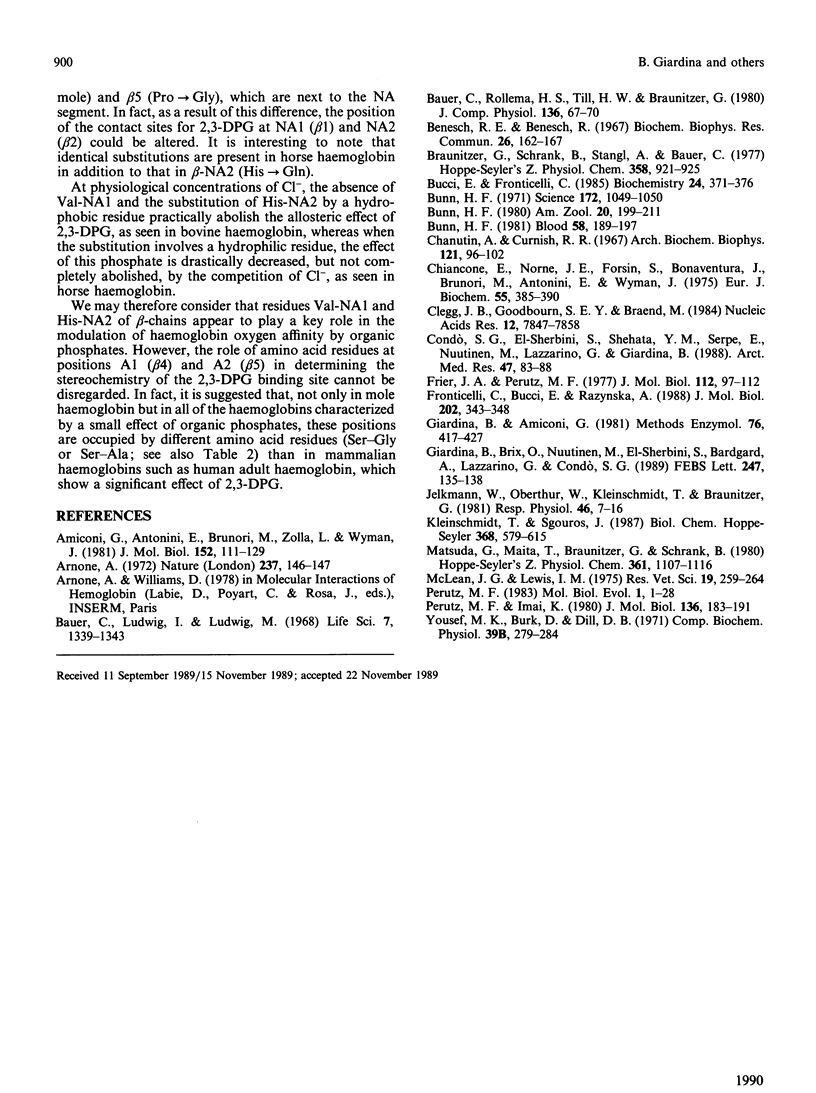Abstract
Despite the fact that the horse is one of the more common domesticated animals, there are few reports dealing with the properties of its blood, and no comprehensive study has been performed on the reactivity of horse haemoglobin towards organic and inorganic ions. Here we report data on the effects of the organic phosphates D-glycerate-2,3-bisphosphate (2,3-DPG) and InsP6, and of chloride on the properties of horse haemoglobin. Thus the effect of saturating concentrations of 2,3-DPG on the oxygen affinity of horse haemoglobin is about 60% lower than with human adult haemoglobin under the same experimental conditions. The same applies also to InsP6, whose effect on oxygen binding to horse haemoglobin is decreased by about 55% compared with human adult haemoglobin. On the whole, horse haemoglobin appears to be much less sensitive to organic phosphates than previously believed. These results are discussed in the light of the primary structure of the molecule.
Full text
PDF



Selected References
These references are in PubMed. This may not be the complete list of references from this article.
- Amiconi G., Antonini E., Brunori M., Wyman J., Zolla L. Interaction of hemoglobin with salts. Effects on the functional properties of human hemoglobin. J Mol Biol. 1981 Oct 15;152(1):111–129. doi: 10.1016/0022-2836(81)90097-8. [DOI] [PubMed] [Google Scholar]
- Arnone A. X-ray diffraction study of binding of 2,3-diphosphoglycerate to human deoxyhaemoglobin. Nature. 1972 May 19;237(5351):146–149. doi: 10.1038/237146a0. [DOI] [PubMed] [Google Scholar]
- Benesch R., Benesch R. E. The effect of organic phosphates from the human erythrocyte on the allosteric properties of hemoglobin. Biochem Biophys Res Commun. 1967 Jan 23;26(2):162–167. doi: 10.1016/0006-291x(67)90228-8. [DOI] [PubMed] [Google Scholar]
- Braunitzer G., Schrank B., Stangl A., Bauer C. Die Regulation der Höhenatmung und ihre molekulare Deutung: Die Sequenz der beta-Ketten der Hämoglobine des Schweines und des Lamas. Hoppe Seylers Z Physiol Chem. 1977 Jul;358(7):921–925. [PubMed] [Google Scholar]
- Bucci E., Fronticelli C. Anion Bohr effect of human hemoglobin. Biochemistry. 1985 Jan 15;24(2):371–376. doi: 10.1021/bi00323a020. [DOI] [PubMed] [Google Scholar]
- Bunn H. F. Differences in the interaction of 2,3-diphosphoglycerate with certain mammalian hemoglobins. Science. 1971 Jun 4;172(3987):1049–1050. doi: 10.1126/science.172.3987.1049. [DOI] [PubMed] [Google Scholar]
- Bunn H. F. Evolution of mammalian hemoglobin function. Blood. 1981 Aug;58(2):189–197. [PubMed] [Google Scholar]
- Chanutin A., Curnish R. R. Effect of organic and inorganic phosphates on the oxygen equilibrium of human erythrocytes. Arch Biochem Biophys. 1967 Jul;121(1):96–102. doi: 10.1016/0003-9861(67)90013-6. [DOI] [PubMed] [Google Scholar]
- Chiancone E., Norne J. E., Forsén S., Bonaventura J., Brunori M., Antonini E., Wyman J. Identification of chloride-binding sites in hemoglobin by nuclear-magnetic-resonance quadrupole-relaxation studies of hemoglobin digests. Eur J Biochem. 1975 Jul 1;55(2):385–390. doi: 10.1111/j.1432-1033.1975.tb02173.x. [DOI] [PubMed] [Google Scholar]
- Clegg J. B., Goodbourn S. E., Braend M. Genetic organization of the polymorphic equine alpha globin locus and sequence of the BII alpha 1 gene. Nucleic Acids Res. 1984 Oct 25;12(20):7847–7858. doi: 10.1093/nar/12.20.7847. [DOI] [PMC free article] [PubMed] [Google Scholar]
- Condó S. G., el-Sherbini S., Shehata Y. M., Serpe E., Nuutinen M., Lazzarino G., Giardina B. Regulation of the oxygen affinity of haemoglobin from the reindeer (Rangifer tarandus tarandus L.). Arctic Med Res. 1988 Apr;47(2):83–88. [PubMed] [Google Scholar]
- Frier J. A., Perutz M. F. Structure of human foetal deoxyhaemoglobin. J Mol Biol. 1977 May 5;112(1):97–112. doi: 10.1016/s0022-2836(77)80158-7. [DOI] [PubMed] [Google Scholar]
- Fronticelli C., Bucci E., Razynska A. Modulation of oxygen affinity in hemoglobin by solvent components. Interaction of bovine hemoglobin with 2,3-diphosphoglycerate and monatomic anions. J Mol Biol. 1988 Jul 20;202(2):343–348. doi: 10.1016/0022-2836(88)90463-9. [DOI] [PubMed] [Google Scholar]
- Giardina B., Amiconi G. Measurement of binding of gaseous and nongaseous ligands to hemoglobins by conventional spectrophotometric procedures. Methods Enzymol. 1981;76:417–427. doi: 10.1016/0076-6879(81)76133-0. [DOI] [PubMed] [Google Scholar]
- Giardina B., Brix O., Nuutinen M., el Sherbini S., Bardgard A., Lazzarino G., Condò S. G. Arctic adaptation in reindeer. The energy saving of a hemoglobin. FEBS Lett. 1989 Apr 10;247(1):135–138. doi: 10.1016/0014-5793(89)81256-6. [DOI] [PubMed] [Google Scholar]
- Jelkmann W., Oberthür W., Kleinschmidt T., Braunitzer G. Adaptation of hemoglobin function to subterranean life in the mole, Talpa europaea. Respir Physiol. 1981 Oct;46(1):7–16. doi: 10.1016/0034-5687(81)90064-5. [DOI] [PubMed] [Google Scholar]
- Kleinschmidt T., Sgouros J. G. Hemoglobin sequences. Biol Chem Hoppe Seyler. 1987 Jun;368(6):579–615. [PubMed] [Google Scholar]
- Matsuda G., Maita T., Braunitzer G., Schrank B. Hämoglobine, XXXIII: Notiz zur Sequenz der Hämoglobine des Pferdes. Hoppe Seylers Z Physiol Chem. 1980 Jul;361(7):1107–1116. [PubMed] [Google Scholar]
- McLean J. G., Lewis I. M. Oxygen affinity responses to 2,3-diphosphoglycerate, and methaemoglobin formation in horse and human haemoglobins. Res Vet Sci. 1975 Nov;19(3):259–262. [PubMed] [Google Scholar]
- Miwa I., Erdös E. G., Seki T. Presence of three peptides in urinary kinin (substance Z) preparations. Life Sci. 1968 Dec 15;7(24):1339–1343. doi: 10.1016/0024-3205(68)90265-8. [DOI] [PubMed] [Google Scholar]
- Perutz M. F., Imai K. Regulation of oxygen affinity of mammalian haemoglobins. J Mol Biol. 1980 Jan 15;136(2):183–191. doi: 10.1016/0022-2836(80)90312-5. [DOI] [PubMed] [Google Scholar]
- Perutz M. F. Species adaptation in a protein molecule. Mol Biol Evol. 1983 Dec;1(1):1–28. doi: 10.1093/oxfordjournals.molbev.a040299. [DOI] [PubMed] [Google Scholar]
- Yousef M. K., Burk D., Dill D. B. Biochemical properties of the blood of three equines. Comp Biochem Physiol B. 1971 Jun 15;39(2):279–284. doi: 10.1016/0305-0491(71)90170-2. [DOI] [PubMed] [Google Scholar]


